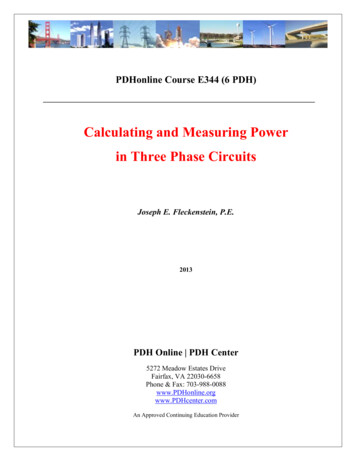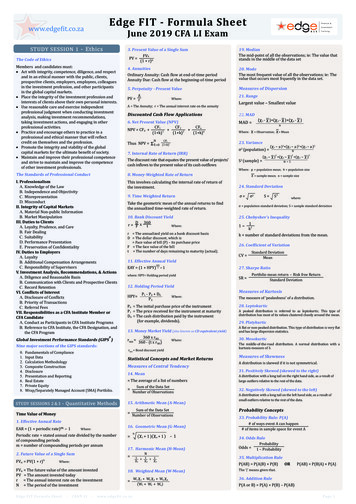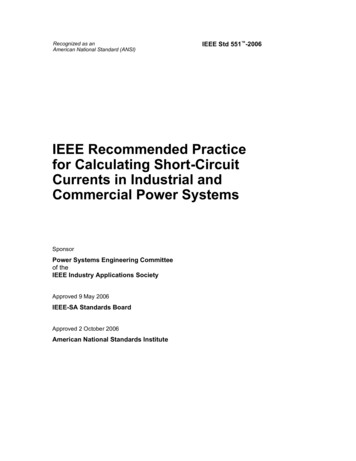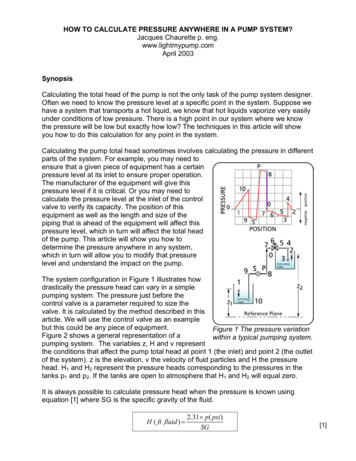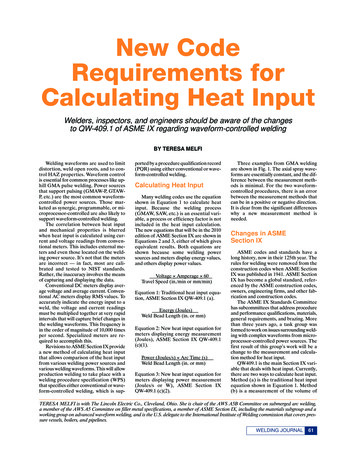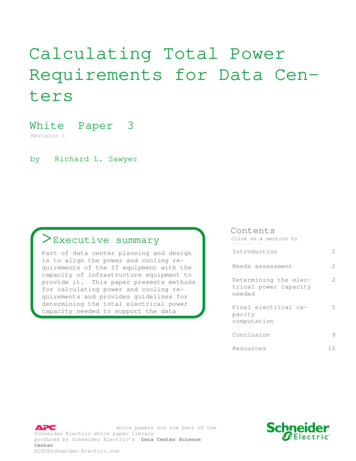
Transcription
Calculating Total PowerRequirements for Data CentersWhitePaper3Revision 1byRichard L. Sawyer ExecutiveContentssummaryPart of data center planning and designis to align the power and cooling requirements of the IT equipment with thecapacity of infrastructure equipment toprovide it. This paper presents methodsfor calculating power and cooling requirements and provides guidelines fordetermining the total electrical powercapacity needed to support the datacenter including IT equipment coolingClick on a section tojump to itIntroduction2Needs assessment2Determining the electrical power capacityneeded2Final electrical capacitycomputation5Conclusion9Resourceswhite papers are now part of theSchneider Electric white paper libraryproduced by Schneider Electric’s Data Center ScienceCenterDCSC@Schneider-Electric.com10
Calculating Total Power Requirements for Data CentersIntroductionWith the adoption of scalable “pay as you grow” uninterruptible power supply (UPS) architectures, it’s becoming easier to install these systems. It allows the data center manager tosimply add modules as the needs of the data center grow. However, it is easy to lose sight ofthe future electrical needs of the data center or data room within a larger facility.Sizing the electrical service for a data center or data room requires an understanding of theamount of electricity required by the cooling system, the UPS system, and the critical ITloads. The power requirements of these elements may vary substantially from each other,but can be accurately estimated using simple rules once the power requirements of theplanned IT load are determined. In addition to estimating the size of the electrical service,these elements can be used to estimate the power output capacity of a standby generatorsystem, if one is required for the data center loads.NeedsassessmentRelated resourceWhite Paper75Comparing UPS SystemDesign ConfigurationsAny initiative to improve the capabilities of a data center environment, no matter the size orscale, must begin with a needs assessment. The needs assessment essentially establishesthe availability needs of the business applications being processed by the IT equipment. Abusiness process that is not time sensitive, or is batch process driven may dictate power andair conditioning for the load in an “N” configuration, with no internal redundancies to increaseavailability. More time sensitive sites may require a degree of redundancy in key componentsystems and have configurations of an “N 1” topology. Every key system element wouldhave a redundant piece of equipment so that if one of the units fails, the system could stillmaintain its function for the IT critical load. The most critical data center applicationsrequiring total availability (7x24) would have a 2N topology where critical systems would becompletely redundant. One critical system could fail, but another would maintain operationalloads. This also provides for a degree of concurrent maintainability whereby maintenancecould be performed on one system while another supplies the load. For more information onthe different types of system configurations see White Paper 75, Comparing UPS SystemDesign Configurations.No matter what the actual UPS system design configuration is (N, N 1, 2N), the core issue ofproviding sufficient power to the critical load and keeping it cool is the same, and must becarefully addressed. Underestimating the required capacity may result in future powerdisruptions when forced to increase capacity, and over estimating leads to excessive initialinstallation costs and higher ongoing maintenance expenses.Determiningthe electrical powercapacityneededMost data centers are part of a larger building. The steps in determining the electricalcapacity described below will assist in estimating the capacity required for that portion of thebuilding dedicated to the data center or data room. The difference between the steady statepower and the peak power is important when calculating power capacity requirements and isnoted throughout this paper. For more information on why power variations exist read WhitePaper 43, Dynamic Power Variations in Data Centers and Network Rooms. For installationswhere critical components like air conditioning, chillers, or standby generators are shared andused to supply other loads beyond the data center, the sizing of the system requires a morecomplete and complex analysis by a consulting engineer.Related resourceWhite Paper43Dynamic Power Variations in Data Centersand Network RoomsFigure 1 illustrates a typical breakdown of how the electrical capacity is divided among thevarious loads in a data center. This breakdown assumes 5,000 ft2, (465 m2) data center withan initial steady state critical load of 50 kW, plus a future steady state load of 50 kW. Thecooling system is assumed to be direct expansion (DX) and the utility voltage is 480 volts AC.Schneider Electric – Data Center Science CenterWhite Paper 3 Rev 12
Calculating Total Power Requirements for Data CentersLighting3%DX cooling system50%UPS ineffiency /battery charging11%Figure 1Breakdown of datacenter electricalrequirementsCritical loads36%Critical loadsA proper planning exercise in developing a data center, from a single rack sized environmentto a full scale data center begins with determining the size of the critical load that must beserved and protected. The critical load is all of the IT hardware components that make up theIT business architecture: servers, routers, computers, storage devices, telecommunicationsequipment, etc., as well as the security systems, fire and monitoring systems that protectthem. This process begins with a list of all such devices, with their nameplate power rating,their voltage requirements, and whether they are single phase or three phase devices. Thenameplate information must then be adjusted to reflect the true anticipated load. Thenameplate power requirements are the worst-case power consumption numbers required byUnderwriter’s Laboratory and in almost all cases, are well above the expected operatingpower level. Studies conducted by reputable consulting engineering firms and power supplymanufacturers indicate that the nameplate rating of most IT devices is well in excess of theactual running load by a factor of at least 33%. The U.S. National Electrical Code (NEC) andsimilar worldwide regulatory bodies also recognize this fact and allow electrical systemplanners to add up nameplate data for anticipated loads and multiply by a diversity factor,anticipating that not all devices are running at full load 100% of the time. Alternatively, anadvanced sizing calculator may be used such as the one found at the website below.Calculators such as this one gather power consumption data from a wide range of manufactures and further specify various equipment configurations.UPS SelectorAt this site an IT professional can configure a representative rack’s worth of servers based on“brand-name” ingredients. This tool works behind the scenes to add up the known powerrequirements of each component within a given server’s configuration. For example, when auser specifies a server, they will also be asked to record the quantity of CPU and otherdetails within the box. Given the user’s inputs, the UPS Selector will calculate the total powerrequired for the rack. (The power will be stated in volt-amps or VA) Also included in the toolare important facts about the manufacturers intended input voltage and power plug.With the list of anticipated components comprising the critical load, the base load can beestablished by using a sizing calculator. For IT equipment unlisted in calculators as well asthe power requirement for fire, security and monitoring systems, the following process shouldbe used:1. Add up the nameplate power of the anticipated loads. If the wattage is not listed onthe device, it can be determined by multiplying the current (amps) by the voltage of theSchneider Electric – Data Center Science CenterWhite Paper 3 Rev 13
Calculating Total Power Requirements for Data Centersdevice to get the VA, which approximates the amount of watts the device will consume.2. Multiply the anticipated VA number by 0.67 to estimate the actual power, in watts, thatthe critical load will represent.3. Divide the number by 1,000 to establish the kilowatt (kW) load level of the anticipatedcritical load.Future loadsRelated resourceWhite Paper37Avoiding Costs fromOversizing DataCenter and NetworkRoom InfrastructureData Center loads are not static. Once built or established, the IT equipment will be under analmost constant state of change during the lifetime of the data center. IT “refreshes” will, at aminimum, have a 3 year cycle where new, more powerful or efficient devices will be installedwith, or replace the devices on the initial planning list. A realistic assessment of the scopeand timing of future changes and upgrades should be developed by the IT organization toallow proper planning for the initial determination of power requirements. The “downstream”elements of the electrical power and distribution system can be scaled, or adjusted to knownloads and future loading (See White Paper 37, Avoiding Costs from Oversizing Data Centerand Network Room Infrastructure), but the electrical power service supplying the data centerphysical infrastructure (DCPI) components has to be sufficiently sized to carry the known loadat start-up and future loads, or provision has to be made for installing additional capacitywithout incurring excessive downtime that would adversely affect the availability expected bythe IT customer.Once an estimate is made for the amount of future loading, it is added to the base loadinginformation developed above to establish the electrical critical load number in kW.UPS loadsAssuming that the availability determination in the needs assessment, explained above,requires the inclusion of UPS power (in almost all cases this is true), the total electrical loadpower must include a factor for the inefficiency of the UPS system as well as the additionalpower required for battery charging.UPS efficiency varies between product models and varies dramatically depending on theloading of the UPS. UPS are rarely run at the operating points where their advertisedefficiency is provided. A realistic and sufficiently accurate value for UPS efficiency in atypical installation is 88%.Battery charging is a significant but intermittent power consumer. Under normal operationwith a charged battery the battery charging load is negligible. However, when a battery hasbeen partially or completely discharged the battery charging power can be on the order of20% of the rated UPS load. Although this load only rarely occurs, the generator and serviceentrance must be sized for this load.Lighting loadsRelated resourceWhite PaperWeather Lighting loads account for all the lighting in the data center portion of the buildingand are a function of the data center floor area. A good rule of thumb for this type of load is 2watts per square foot or 21.5 watts per square meter.25Calculating TotalCooling Requirementsfor Data CentersCooling loadsRefer to White Paper 25, Calculating Total Cooling Requirements for Data Centers, for adetailed discussion of heat loads in data center environments. The paper provides a table tohelp calculate the cooling required for the heat generated by the IT equipment. It also allowsthe planner to establish the amount of cooling required to support a planned critical load.Schneider Electric – Data Center Science CenterWhite Paper 3 Rev 14
Calculating Total Power Requirements for Data CentersCooling systems vary widely in efficiency but can be broken down into chilled water systemsand direct expansion systems. Chilled water systems are generally more efficient and a ruleof thumb for power consumption is 70% of the total peak load being supported. Directexpansion systems require about 100% of the total peak load being supported. Note thatcooling loads have startup peak loads that exceed the steady state values, which areaccounted for in this calculation. Table 1 of this paper estimates the electrical powerrequirement of the cooling system using these rules. This will help establish the size of theelectrical distribution system required to support the entire data center.Sizing the electrical power systemTwo important numbers have been determined that will assist in estimating the size of theelectrical system that will power the data center environment: the total critical load and thetotal cooling load. In general, the electrical supply must be large enough to support the sumof these two numbers, plus the related data center lighting loads.The steady-state power consumption of the loads within a data center establishes the powerconsumption for purposes of determining electrical costs. However, the electrical service andthe generator power sources that provide power to the data center cannot be sized to thesteady state values. These sources must be sized to the peak power consumption of theloads, plus any derating or oversizing margins required by code or standard engineeringpractice. In practice, this causes the electrical service and generator sizing to be substantially larger than might be expected, as will be illustrated in the next section.Final electrical capacitycomputationOnce the total electrical capacity is estimated in kW from the process described above, twocritical determinations can be made: the first is an estimate of the electrical service neededto supply the data center, and the second is the size of any standby power generator capacitythat may be needed to achieve the desired availability.Sizing of the electrical serviceThe electrical service can be calculated as follows:1. Take the total electrical capacity required in kilowatts and multiply by 125% to meetthe requirements of the National Electrical Code and similar regulatory bodies.2. Determine the three phase AC voltage of the service entrance to be supplied by theutility company. Typically this is 480 Volts AC in the United States and 230 Volts ACin most other parts of the world.3. Use the following formula to determine the electrical service size to supply the datacenter, in Amps:Amps (kW x1000) / (Volts x 1.73)This provides an estimate of the electrical service capacity required to support the criticalload, cooling, and the building functions for a data center. Using the same assumptions ofFigure 1, Figure 2 emphasizes the important distinction between rated (peak) power andsteady state power by comparing the electrical service requirements for both. It must benoted that this is only an estimate, and that the final determination of the service size is highlydependent on accurate site specific information. It is strongly recommended that the servicesof a qualified professional consulting engineer be retained to verify the initial estimate anddevelop the final data center electrical supply design. Table 1, located at the end of thepaper, can be used as a worksheet that assists in summarizing the discussion above.Schneider Electric – Data Center Science CenterWhite Paper 3 Rev 15
Calculating Total Power Requirements for Data Centers400350300250Rated vs. steadystate electricalservice power for atypical 100 kWcritical load.Electrical servicerating is almost 4Xthe steady statecritical load valuekWFigure 2Air Conditioner Load200Air Conditioner Load150UPS LoadUPS Load100Critical LoadCritical LoadElectric Service RatedElectric Service Steady State500Critical LoadLighting LoadAir Conditioner LoadElectrial Service DeratingUPS LoadSizing of generator standby power systemsOnce the size of the electrical service has been determined, consideration can be given tosizing of an appropriate standby power generator, which will provide power in the event of autility failure and increase the availability of the data center. A typical generator installation isillustrated in Figure 3 below:UtilityGeneratorTransfer SwitchFigure 3Emergency BusTypical generatorsystemUPSMechanical Loads(Air Conditioning)Other Loads(Lighting, etc.)Critical IT LoadSchneider Electric – Data Center Science CenterWhite Paper 3 Rev 16
Calculating Total Power Requirements for Data CentersThe first thing to note on the diagram above is the assumption that the data center is the onlyload, and that it is to be fully protected by standby power. The “utility” supply may be only apart of a standard commercial electrical distribution system, so this diagram would be part ofa subset of a much larger electrical system. This subset is the data center portion thatsupplies the critical IT loads.To estimate the size of the generator required for the critical loads, use the calculation at thebottom of Table 1. However, there has to be consideration of the electrical characteristics ofthe loads to be attached to the generator through the transfer switch. Mechanical loads, forexample, require high starting currents and impose harmonic currents that pose problems toa generator’s ability to supply the power needed. The UPS itself may contribute to thisproblem if it does not operate at a high input power factor, and may cause generator failure ifit imposes a leading power factor on the generator.The selection of a UPS system with operating characteristics favorable to reliable generatoroperation is an extensive discussion, not covered in this white paper. It is sufficient to notethat the UPS must be chosen carefully to achieve end-to-end reliability. A UPS system thatexhibits highly capacitive characteristics under low load conditions is to be avoided. CertainUPS topologies, such as the delta conversion, are ideal for generator supplied systems andwill not produce the undesirable operating characteristics of traditional double conversionsystems with input filter capacitors. This choice alone in the selection of the UPS caninfluence the required generator size greatly, frequently by a factor of 3 (the generator wouldhave to be 1.75 to 3 times larger for a typical double conversion UPS than a delta conversionUPS). As in the case of electrical service power, Figure 4 emphasizes the importantdistinction between rated (peak) power and steady state power by comparing the electricalgenerator requirements for both.Related resourceWhite Paper15Watts and Volt-Amps:Powerful ConfusionWhen selecting a generator, base the choice on the kW rating of the generator for purposesof simplicity, but be aware that generators are designed to operate loads at a lower powerfactor than 1.0, typically 0.8. This means that the current and voltage will be slightly out ofphase and that the generator must withstand that difference. A 1000 kW generator, designedto operate loads having a power factor of 0.8 will be rated at 1200 kVA. Do not confuse thekVA rating with the true power capacity of the generator, which is always in kW. For moreinformation on power factor see White Paper 15, Watts and Volt-Amps: Powerful Confusion.450400350300Rated vs. steadystate electricalgenerator power fora typical 100 kWcritical load.Electrical servicerating is over 4Xthe steady statekWFigure 4250200Air Conditioner LoadAir Conditioner Load150UPS LoadUPS Load100Critical LoadCritical LoadGenerator RatedGenerator Steady State500Critical LoadLighting LoadUPS LoadAir Conditioner LoadOversizing due to Critical loadsOversizing due to Cooling loadsSchneider Electric – Data Center Science CenterWhite Paper 3 Rev 17
Calculating Total Power Requirements for Data CentersTable 1Data center power requirementestimate calculation worksheetItemData requiredCalculationSubtotal kWPower requirement – electricalCritical load- sizing calculatorvalue from Schneider ElectricwebsiteRating of each IT deviceFor equipment not listed in thesizing calculator, critical load –nameplateSubtotal VA (include fire, securityand monitoring systems)Future Loads( Calculator total in VA x 0.67 ) / 1000# 1 kW( Subtotal VA x .67 ) / 1000# 2 kWVA of nameplate of each anticipatedIT device[ (Add VA rating of future devices) x .67 ]/ 1000# 3 kWPeak power draw due to variationin critical loadsTotal steady state critical load powerdraw( # 1 # 2 # 3 ) x .1.05# 4 kWUPS inefficiency and batterychargingActual Load Future Loads (in kW)( # 1 # 2 # 3 ) x 0.32# 5 kWLightingTotal floor area associated with thedata center0.002 x floor area (sq ft), or 0.0215 xfloor area (sq m)# 6 kWTotal power to supportelectrical demandsTotal from # 4, # 5, and # 6 above#4 #5 #6# 7 kWPower requirement – coolingTotal power to support coolingdemandsTotal from # 7 aboveFor Chiller systems # 7 x 0.7For DX systems# 7 x 1.0# 8 kWTotal power requirementTotal power to supportelectrical and cooling demandsTotal from # 7 and # 8 above#7 #8# 9 kW# 9 x 1.25# 10 kWSize of electrical service estimateRequirements to meet NEC andother regulatorsTotal from # 9 aboveThree phase AC voltage providedat service entranceAC voltageElectrical service required fromutility company in AmpsTotal from # 10 and AC voltage in# 11# 11 VAC( # 10 x 1000) / ( # 11 x 1.73 )AmpsSize of standby generator estimate (if applicable)Critical loads requiring generatorback upTotal from # 7 above# 7 x 1.3*# 12 kWCooling loads requiring generatorback upTotal from # 8 above# 8 x 1.5# 13 kWSize of generator neededTotal from # 12 and # 13 above# 12 # 13kW*WARNING: The 1.3 variable applies to fully power factor corrected UPS. A 3.0 multiplier must be usedwhen using traditional double conversion UPS with input harmonic filters.Schneider Electric – Data Center Science CenterWhite Paper 3 Rev 18
Calculating Total Power Requirements for Data CentersConclusionAssessing the electrical power required to support and cool the critical loads within the datacenter is essential in planning for the development of a facility that will meet the end user’savailability expectations. By employing the process described above, a reasonable estimateof the power requirements can be made. This will help specify the size of the Data centerphysical infrastructure components that will achieve the availability determined by the needsassessment. Once the sizing determination is made, conceptual and detailed planning cango forward with the assistance of a competent DCPI systems supplier or, in the case of largerscale data centers, a consulting engineer. Cost estimation can then be made based on thesize and reliability configuration determined from the power needs assessment processdescribed above.AcknowledgeSpecial thanks to Richard L. Sawyer for authoring the original content of this white paper.Schneider Electric – Data Center Science CenterWhite Paper 3 Rev 19
Calculating Total Power Requirements for Data CentersResourcesClick on icon to linkto resourceComparing UPS System DesignConfigurationWhite Paper 75Browse allwhite paperswhitepapers.apc.comDynamic Power Variations in DataCenters and Network RoomsWhite Paper 43Avoiding Costs from Oversizing DataCenter and Network Room InfrastructureWhite Paper 37Calculating Total Cooling Requirementsfor Data CentersWhite Paper 25Watts and Volt-Amps: Powerful ConfusionWhite Paper 15Browse allTradeOffltools.apc.comContactusFor feedback and comments about the content of this whitepaper:Data Center Science CenterDCSC@Schneider-Electric.comIf you are a customer and have questions specific to yourdata center project:Schneider Electric – Data Center Science CenterWhite Paper 3 Rev 110
tions.Learnmore
It allows the data center manager to simply add modules as the needs of the data center grow. However, it is easy to lose sight of the future electrical needs of the data center or data room within a larger facility. Sizing the electrical service for a data center or
